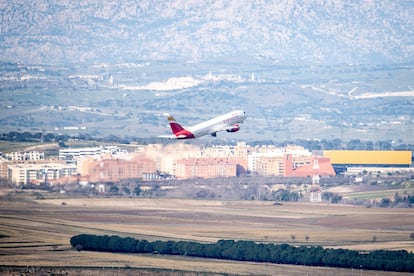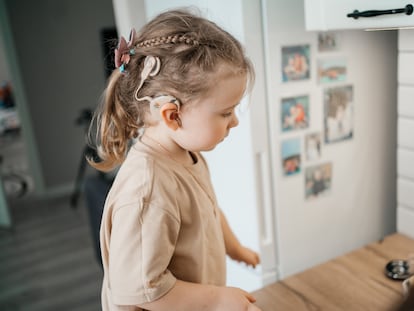These improvements in aircraft design seek to reduce noise, decibel by decibel
Two European projects are investigating how to stop noise pollution from the aviation sector, which disrupts sleep and harms the health of people living near airports

In mid-December 2023, a demonstration in Ireland revealed the strength of public concerns about noise caused by commercial airplanes. Protesters gathered outside the county offices where the Dublin Airport Authority was discussing a planned expansion. “Wrong way DAA!” the people chanted.
Testy times
Such reactions are common across Europe as airports strive for more business and residents under the flight path seek relief from the sound of jetliners when they take off and land. In September, Schiphol Airport in the Netherlands capped its flights because of noise concerns, dismaying airlines as their bottom lines were hit.
This tension between commercial and public interests has prompted researchers to seek ways for planes to fly more quietly. With around 30,000 flights a day in Europe, preventing ill health has been a prime driver of the research efforts.
“At takeoff in particular, but also at landing, aircraft make a lot of noise,” said Dr Werner Haase, a German aeronautics consultant and aerodynamics expert with a doctorate from the Technical University of Berlin. ‘If you’re sleeping and a plane flies over your home, that’s very disruptive. The social impact of that kind of noise is quite high.”
While individual planes have become around 75% quieter over the past three decades and road transport causes significantly more noise than aviation, increases in air traffic have resulted in noise disturbances for great numbers of people.
In Europe, 22 million people have “chronic high annoyance” as a result of environmental noise including from planes, according to the European Commission, which cites related illnesses such as cardiovascular diseases, stress and tinnitus. It says that 12,000 premature deaths are caused each year by long-term exposure to environmental noise and that 12,500 school children face learning impairment from aircraft noise alone.
Noise pollution is the second-biggest environmental cause of health troubles after air contamination, according to the World Health Organization. Through a “zero pollution action plan” dating to 2021, the Commission aims to decrease the share of people chronically disturbed by transport noise by 30% this decade.
Wing flaps and slats
An EU-funded project called INVENTOR wants to make landings in particular less intrusive for the inhabitants below. The focus is on the landing gear, the flaps at the back of the wings and the slats at the wing fronts.
When an aircraft approaches an airport, the landing gear is down and the flaps and slats are deployed to increase the lift at low speed, according to Dr. Eric Manoha, head of the Computational Aeroacoustics Research Unit at French aerospace research center ONERA.
“The aircraft follows a gentle descent along a standardized route,” he said. “This means that aircraft are constantly flying at low altitude over the homes of the same group of people.”
Manoha leads INVENTOR, which began in May 2020 and runs until the end of October 2024. Bringing together major European aircraft makers Airbus and Dassault and landing-gear manufacturer Safran Landing Systems, it is homing in on the noise that emanates from wing flaps and slats and from the landing gear.
While plane engines are a major source of noise at takeoff, making flaps and slats as well as the landing gear quieter can produce a big overall improvement during approaches and landings when engines are less noisy.
“Roughly 30% to 50% of the noise caused by an aircraft in these stages of the flight comes from the airframe, not the engine,” said Manoha.
Air flows
The INVENTOR team is testing — and planning to propose to the aviation industry — a range of design changes to lower decibel levels. One is to place a passive porous structure in front of the landing gear so that the surrounding airflow interacting with the structure is altered and noise is muffled. Another is to install an active device on the landing gear that blows air out. This would create an “air curtain” that, again, cuts noise by diverting the airflow. The landing gear also has to be considered when trying to reduce noise from wing flaps, which are extended during landing and takeoff to provide more lift and drag.
“The wake of the landing gear impacts the flaps,” said Manoha. “This causes noise.”
The project team is placing a porous material on the flap to reduce the noise generated by the flow around the flap. It’s also examining options to reduce slat noise with porous materials and the noise generated by mechanical devices used to deploy the slats.
Decibel decline
Quieter planes will emerge mainly from the cumulative effects of such design improvements, rather than from any single one of them. For example, the latest generation of single-aisle aircraft generates around 75-80 decibels of noise during landing.
“We’re aiming for a one to three decibel reduction per airframe element,” said Manoha. “Each step forward is progress.”
In any case, residents near European airports will have to remain patient. Although some technologies might be retrofitted on existing aircraft, significant relief from air-traffic sounds may come only with the next generation of passenger jets.
Motoring along
A separate EU-funded project that has just ended — and that Haase led — took a broader approach to the whole challenge. Called DJINN, the project improved the simulation methods used by aircraft manufacturers to predict how loud their planes will be. It ran from June 2020 through November 2023 and used advanced numerical methods and high-performance computing to predict fluid flows and improve the aerodynamic and acoustic performance of aircraft. Its findings will help plane manufacturers experiment with design options to reduce noise.
“These methods became more accurate than what industry uses today to calculate noise,” said Haase. “This is something the industry is looking for because they want to improve their designs.”
In contrast to INVENTOR, DJINN looked at the noise generated by both the engines and the airframe and included plane-engine manufacturers Rolls-Royce and Safran Aircraft Engines as project participants.
Engine covers
One possible design change that the DJINN team examined is a jagged shape of the engine outlet. Serrated engine covers have been shown in certain tests to reduce noise from aircraft engines and already feature in some Boeing models. So far Airbus has opted against serrated engine covers, citing a lack of gains in tackling noise. Other options, including the use of porous flaps, exist to reduce noise.
“They all have their pros and cons,” Haase said. “The question of which is the preferable approach remains open.”
In any case, while changes to planes themselves may not come immediately, both Haase and Manoha are optimistic about the prospects for reducing aircraft noise given the research advances taking place. In that context, the airline industry has an incentive to accelerate change because airports in Europe increasingly modulate landing and takeoff fees on the basis of planes’ noise levels. This practice reflects growing environmental concerns and public outcries like the one in Ireland last month.
“Aircraft noise is disrupting the lives of certain people every single day,” said Manoha. “New technology can help us reduce this burden.”
Research in this article was funded by the EU’s Horizon Programme. This article first appeared in Horizon, the European Union’s research and innovation magazine.
Sign up for our weekly newsletter to get more English-language news coverage from EL PAÍS USA Edition
Tu suscripción se está usando en otro dispositivo
¿Quieres añadir otro usuario a tu suscripción?
Si continúas leyendo en este dispositivo, no se podrá leer en el otro.
FlechaTu suscripción se está usando en otro dispositivo y solo puedes acceder a EL PAÍS desde un dispositivo a la vez.
Si quieres compartir tu cuenta, cambia tu suscripción a la modalidad Premium, así podrás añadir otro usuario. Cada uno accederá con su propia cuenta de email, lo que os permitirá personalizar vuestra experiencia en EL PAÍS.
¿Tienes una suscripción de empresa? Accede aquí para contratar más cuentas.
En el caso de no saber quién está usando tu cuenta, te recomendamos cambiar tu contraseña aquí.
Si decides continuar compartiendo tu cuenta, este mensaje se mostrará en tu dispositivo y en el de la otra persona que está usando tu cuenta de forma indefinida, afectando a tu experiencia de lectura. Puedes consultar aquí los términos y condiciones de la suscripción digital.
More information
Archived In
Últimas noticias
Most viewed
- Alain Aspect, Nobel laureate in physics: ‘Einstein was so smart that he would have had to recognize quantum entanglement’
- Mexico’s missing people crisis casts a shadow over World Cup venue
- Why oil has been at the center of Venezuela-US conflicts for decades
- Trump clarifies who is ultimately in charge in Venezuela: ‘Me’
- Mexico seeks to shore up its defenses following US incursion in Venezuela










































